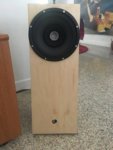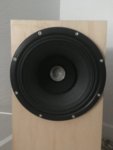
It all started innocently enough. A few years ago I purchased a pair of Magnepans- I had always wanted a pair. Then I went through a few different amplifiers attempting to find the right match. Later we bought another house and moved. The square footage of the new house is nearly identical to the old, but the layout is different, so the size of my listening room (the living room) took a significant hit. The Magnepans looked positively gigantic. And as good as they sounded, I still wasn't getting the sound I was looking for. The rest of the system was pretty well set. I started entertaining the idea of another pair of speakers.
The Zu Difference
Zu Audio marches to the beat of their own drummer. Instead of designing by computer, head honcho Sean Casey uses his decades of experience and research combined with his physics background to design by ear. Casey has read all of the old speaker design books and listened to the classic designs from the golden age of hi fi. He believes that a nearly full range design with one (or two) speakers reproducing nearly the full frequency range sounds best. He adds a tweeter only to capture the highest frequencies. Additionally, he believes that crossovers are “tone killers”. Instead of a printed circuit board full of resistors, capacitors and inductors, Casey uses a single high quality capacitor. This acts to block all but the highest frequencies from the tweeter.
This means that the signal from the amplifier is connected directly to the speaker itself. Most of the time, the amplifier is connected to the crossover inside the speaker cabinet- that printed circuit board full of stuff. It's like a Guinsu knife. It slices and dices the signal sending some to the woofer and some to the tweeter. If the speaker has a midrange driver, there's some additional slicing and dicing.
Why would a speaker manufacturer want to do this? It's pretty simple actually-many speaker manufacturers buy their raw parts from outside vendors. Pick a woofer from manufacturer A and a tweeter from manufacturer B. What if they don't match in output- say the tweeter is too hot? Add a resistor. Problem solved.
The difference between using multiple drivers and a crossover versus a full range design can be compared to buying a suit. You can buy a suit off the rack and the tailor will alter it to make it fit- a nip here, a tuck there and hem the slacks. Or you could go to a high end tailor and have your measurements taken and a suit made from them. While both fit, one fits better- the custom suit without alterations. The Zu design is giving as close to an unaltered musical presentation as possible.
Zu has their drivers built to their specification by Eminence in Kentucky. Eminence happens to be the largest speaker manufacturer in the world. You've heard Eminence speakers before, most likely in live venues. Lots of guitar and bass speaker cabinets are equipped with Eminence drivers.
Zu offers all of their speakers factory direct only. This saves buyers the additional markup that a traditional distributor/dealer network would bring. It also allows consumers to communicate directly with them. You can speak with Sean Casey or another member of the team just as I did. There's no pressure to buy- the Zu crew genuinely want you to get the right speakers for you and your system. Custom finishes are available for very reasonable additional charges- they have numerous wood and automotive paint options available. Every pair is custom built for the buyer.
All are backed by a 5 year guarantee and include a 60 day in home audition period with free return shipping (if shipping was paid by the buyer).
Originally what caught my eye was a pair of their Dirty Weekends. These go on sale a few times a year starting at $999 for the pair. My idea was to try a pair and see how I liked them. These come with a 1 year trade up policy- upgrade to another pair of Zus and the entire $999 is credited towards the new pair. As cool as this is, I realized this wasn't ideal for me. Assuming I liked them, I would be wondering what I was missing by not getting the Souls that I really had my eye on. Ultimately I felt that I'd likely not give the Dirty Weekends a fair shake. After speaking with Casey, I gave it some more thought and ultimately ordered a pair of Soul Mk II in natural Maple finish ($2600 per pair base price- $2770 with the custom finish upgrade).

Two things make the Soul the “odd” speaker in the lineup. The cabinet isn't a box, it's an obelisk- wider at the bottom that the top, with each panel tilting towards the top. It's the smallest floor standing speaker they offer and it stands a mere 31.5 inches tall, the base just over 12 inches square. This means they take up just about the same amount of space as smaller speakers on dedicated stands. The Soul is also the only model in the line that uses a coaxial driver: the tweeter is built into the center of the 10.3” driver in place of the usual dust cap. Recessing the tweeter at the mouth of the full range driver is done so that high frequencies arrive at the ear as close in time as possible as lower frequencies.
Around back are high quality binding posts in addition to a proprietary Speakon type connection socket. This is said to offer an even better connection than the usual, and makes it impossible to wire the speakers out of phase at the speaker end. I wired them with my usual Analysis Plus Oval 9 cables.

The speakers are vented at the bottom and come with both ball ended feet for hard surfaces and spikes for carpeted floors. Because they are bottom vented, there must be a gap between the speaker and the floor to let air escape the cabinet- more on this in a bit.
